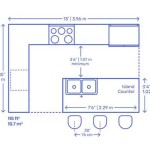How To Tile Kitchen Countertops: A Comprehensive Guide
Tiling kitchen countertops is a cost-effective and aesthetically pleasing way to upgrade a kitchen space. While professional installation is an option, undertaking the project independently can significantly reduce expenses and allow for greater creative control over the final appearance. This article provides a detailed, step-by-step guide on how to tile kitchen countertops, covering preparation, installation, and finishing techniques.
Before commencing the project, it is crucial to understand the inherent challenges and benefits of tiled countertops. Tiled surfaces, while durable, are susceptible to chipping and cracking, particularly around edges and corners. The grout lines, while adding to the aesthetic, can also be challenging to clean and maintain, potentially harboring bacteria and stains. However, with proper installation and regular maintenance, a tiled countertop can provide years of reliable service and enhance the overall design of the kitchen.
The first step involves a thorough assessment of the existing countertop structure. Inspect the surface for any signs of damage, instability, or unevenness. Addressing these issues prior to tiling is paramount to ensuring a long-lasting and visually appealing result. The type of material used for the existing countertop will also influence the preparation methods required.
Key Point 1: Preparation and Material Selection
Proper preparation is the foundation of a successful tiling project. This stage involves cleaning the existing countertop, preparing the surface for adhesion, and gathering all necessary materials and tools. The following sections outline the specific steps involved:
Cleaning the Existing Countertop: Remove all items from the countertop. Thoroughly clean the surface with a degreasing cleaner to remove any grease, oil, or grime. Rinse the surface with clean water and allow it to dry completely. This step is crucial for ensuring proper adhesion of the thin-set mortar.
Preparing the Surface for Adhesion: The preparation method depends on the existing countertop material. For laminate countertops, sanding the surface with coarse-grit sandpaper (e.g., 80-grit) is recommended to create a rough texture that promotes adhesion. After sanding, remove any dust with a damp cloth. For concrete or plywood countertops, ensure the surface is clean and free of any loose debris. Consider applying a concrete primer or a thin layer of thin-set mortar to create a more even and porous surface for better adhesion. If the existing countertop is made of ceramic tile, removing it entirely and starting with a clean substrate is generally recommended. This minimizes the risk of issues arising from the existing tile bond.
Material Selection: Choosing the right materials is critical for the longevity and appearance of the tiled countertop. Essential materials include:
- Tiles: Select tiles that are appropriate for countertop use. Consider factors such as durability, water resistance, and aesthetic appeal. Ceramic, porcelain, and natural stone tiles are common choices. The tile size and shape will influence the overall look and grout line density.
- Thin-set Mortar: Choose a high-quality thin-set mortar specifically designed for tiling countertops. Consider the type of tile being used and the manufacturer's recommendations. Modified thin-set mortars offer enhanced adhesion and flexibility.
- Grout: Select a grout that complements the chosen tiles. Consider the grout color and type. Epoxy grout is more resistant to staining and water absorption than cementitious grout, making it a suitable choice for kitchen countertops.
- Sealer: Apply a sealer to the grout lines to protect them from stains and water damage. Choose a sealer appropriate for the type of grout used. Natural stone tiles may also require sealing.
- Caulk: Use a high-quality caulk to seal the edges where the countertop meets the backsplash or surrounding walls. Choose a caulk that is paintable and resistant to mildew.
- Backer Board (Optional): If the existing countertop is unstable or damaged, installing a cement backer board (e.g., Durock or Wonderboard) can provide a solid and water-resistant substrate for the tiles.
Tools: Gather all necessary tools before starting the project. Essential tools include:
- Tile Saw: A wet saw is recommended for cutting tiles accurately and safely.
- Notched Trowel: Use a notched trowel to apply the thin-set mortar evenly. The notch size should be appropriate for the tile size.
- Grout Float: A grout float is used to apply and spread the grout into the grout lines.
- Grout Sponge: A grout sponge is used to clean the excess grout from the tile surface.
- Level: A level is essential for ensuring that the tiles are installed evenly.
- Measuring Tape: A measuring tape is used to measure the countertop and tiles accurately.
- Pencil: A pencil is used to mark cutting lines on the tiles.
- Safety Glasses: Safety glasses are essential for protecting the eyes from dust and debris.
- Gloves: Gloves protect the hands from the thin-set mortar and grout.
Key Point 2: Tile Installation
With the preparation complete and materials gathered, the next step is to install the tiles. This process requires patience, precision, and attention to detail. The following steps provide a detailed guide:
Dry Layout: Before applying any thin-set mortar, perform a dry layout of the tiles on the countertop. This allows for visualizing the tile arrangement and identifying any necessary cuts. Adjust the tile spacing to achieve a balanced and aesthetically pleasing layout. Use tile spacers to maintain consistent grout lines.
Applying Thin-Set Mortar: Mix the thin-set mortar according to the manufacturer's instructions. Use a notched trowel to apply a thin, even layer of thin-set mortar to a small section of the countertop. The notch size should be appropriate for the tile size. Hold the trowel at a 45-degree angle and apply the mortar in one direction. Avoid applying too much mortar at once, as it can dry out before the tiles are set.
Setting the Tiles: Carefully place the tiles onto the thin-set mortar, pressing them firmly into place. Use tile spacers to maintain consistent grout lines. Ensure that the tiles are level and aligned properly. If necessary, use a rubber mallet to gently tap the tiles into place. Remove any excess thin-set mortar from the grout lines with a small tool or sponge.
Cutting Tiles: Use a wet saw to cut the tiles to fit around edges, corners, and fixtures. Measure the required cuts accurately and mark the cutting lines on the tiles with a pencil. When cutting tiles, wear safety glasses to protect the eyes from dust and debris. Practice cutting on scrap tiles before cutting the actual tiles.
Allowing the Thin-Set Mortar to Cure: Allow the thin-set mortar to cure according to the manufacturer's instructions. This typically takes 24 to 48 hours. Avoid walking on or placing any heavy objects on the tiled surface during the curing process.
Key Point 3: Grouting and Finishing
After the thin-set mortar has cured, the next step is to grout the tile joints. Grouting fills the spaces between the tiles, providing a waterproof seal and enhancing the overall appearance. The finishing touches, such as sealing the grout and caulking the edges, are crucial for protecting the tiled surface and ensuring its longevity.
Applying Grout: Mix the grout according to the manufacturer's instructions. Use a grout float to apply the grout to the tile surface, working it into the grout lines. Hold the grout float at a 45-degree angle and apply the grout in a circular motion. Ensure that all grout lines are completely filled.
Removing Excess Grout: After applying the grout, allow it to set for the time specified by the manufacturer. Use a damp grout sponge to clean the excess grout from the tile surface. Rinse the sponge frequently to remove the grout residue. Avoid using too much water, as it can weaken the grout.
Cleaning and Polishing: After the grout has dried, polish the tile surface with a clean, dry cloth to remove any remaining grout haze. If necessary, use a grout haze remover to remove stubborn residue. Inspect the grout lines for any imperfections and touch up as needed.
Sealing the Grout: Apply a grout sealer to the grout lines to protect them from stains and water damage. Choose a sealer appropriate for the type of grout used. Apply the sealer according to the manufacturer's instructions. Allow the sealer to dry completely before using the countertop.
Caulking the Edges: Apply a bead of caulk to the edges where the countertop meets the backsplash or surrounding walls. Choose a caulk that is paintable and resistant to mildew. Smooth the caulk with a wet finger or a caulking tool. Allow the caulk to dry completely before using the countertop.
Final Inspection: After completing all the steps, inspect the tiled countertop thoroughly. Look for any imperfections, such as uneven tiles, cracked grout lines, or gaps in the caulk. Address any issues promptly to prevent further damage.
Maintaining a tiled kitchen countertop involves regular cleaning with mild soap and water. Avoid using abrasive cleaners or scouring pads, as they can damage the tile and grout. Promptly wipe up spills to prevent staining. Periodically reseal the grout lines to maintain their water resistance. By following these maintenance tips, a tiled kitchen countertop can provide years of beauty and functionality.

Installing Tile Countertops Backsplash Family Handyman

Installing A Tile Countertop Ibuildit Ca
:max_bytes(150000):strip_icc()/brick-style-tile-countertop-5baf9aca46e0fb00264554ab.jpg?strip=all)
12 Tile Kitchen Countertops That Are Surprisingly Fresh

Tile Kitchen Countertops Ideas For Your Home Designcafe

How To Install White Marble Epoxy Over Tile Kitchen Stone Coat Youtube

All You Need To Know About Tile Countertops Bob Vila

Installing A Tile Countertop Ibuildit Ca

Tile Kitchen Countertops Ideas For Your Home Designcafe

Easy Way To Remove Tile Countertops Like A Pro
:max_bytes(150000):strip_icc()/Hexagon-tile-kitchen-countertop-5babfb70c9e77c00250ff6b8.jpg?strip=all)
12 Tile Kitchen Countertops That Are Surprisingly Fresh








